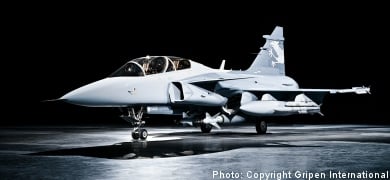Sweden’s defence ministry backed the deal as an important expression of Nordic defence coooperation, and downplayed criticism that the decision to develop the next generation of Saab’s JAS Gripen aircraft was an inappropriate use of funds.
The Gripen and Lockheed Martin’s Joint Strike Fighter/F-35, were presented by their respective companies at a public ceremony in Oslo, but neither disclosed a price for the order, estimated at several billion dollars.
“With two impressive candidates remaining in the competition, I am convinced that we will get a good competition as we enter into the final leg of the race,” Norwegian Defence Minister Anne-Grete Strøm-Erichsen said.
“We will choose the best aircraft for our needs, and hopefully we will also benefit from the competition: price down and the quality up,” she said.
Swedish Minister of Defence Sten Tolgfors was on hand for the presentation.
“This project has the full backing of the Swedish government. That is why I am here today,” Tolgfors told reporters when he handed over Sweden’s offer to Strøm-Erichsen.
The European consortium Eurofighter had previously pulled out of the competition, judging that the selection process in Norway was biased in favour of the Joint Strike Fighter (JSF).
Strøm-Erichsen said she “regretted” that decision.
Norway currently has US-made F-16s.
Some observers have said any choice other than the JSF would jeopardize the historic alliance between the United States and Norway, a NATO member loyal to Washington.
“If Norway buys a product made in Sweden, it could have an impact on our relationship with the United States,” an editorial in the tabloid Verdens Gang, Norway’s biggest newspaper, said on Monday.
“Our close relationship with the United States in terms of defence policy has traditionally been a guarantee for our security,” it said.
But other experts say the Swedish aircraft, which is believed to be cheaper, corresponds better to the needs of the Norwegian Air Force.
Norway is primarily seen as needing fighters that can defend Norway’s sovereignty in the Arctic against Russian planes.
The JSF, which has suffered repeated delays and extra costs, is meanwhile specialized in bombing missions.
Tolgfors emphasized that the deal demonstrated the close ties between Sweden and Norway, and that it could have an impact on the future of Nordic defence cooperation.
“That Sweden can offer the Gripen as an alternative for Norway confirms the strong connections and good relations we have between our two countries,” he said in a statement.
“Nordic defence cooperation is developing more and more, and is a central area of development for defence policy. If Norway chooses the Gripen it would have great significance for defence policy.”
The deal has come under fire from opposition parties in Sweden who view the deal as a misuse of Sweden’s ever-shrinking military budget.
“This is a poor use of money, we don’t need this plane and without putting words in the mouth of the Supreme Commander, I believe that he feels the same way. This is more about industrial policy than defence policy and its inappropriate to formulate our defence policy this way,” said Left Party leader Lars Ohly.
The deal was announced just days after the cash-strapped Swedish military unveiled controversial plans to close several installations in the coming years.
Tolgfors emphasized that the Gripen offer had nothing to do with the base closings.
“These have absolutely nothing to do with each other. The Armed Forces has a deficit it its operating costs for 2008 and 2009. [The Gripen deal] has to do with materiel and investment plans which are in another appropriation,” he said.
According to Tolgfors the cost of converting the current generation of JAS-aircraft into the new Nato-compatible Super-JAS is close to the funding level already set aside to ensure that Sweden’s Gripen remains competitive, estimated to be around 1 billion kronor per year.
“It doesn’t cost any more money than what the Gripen system would have cost,” said Tolgfors to the news agency TT.
“If you have a cost and can choose to pay it yourself or share it with others—which is cheapest? We get more money for our money if we do things together with others. That’s the whole point behind Nordic defence cooperation.”
The costs to be shared include development and maintenance, as well as common pilot training and technicians, and joint training exercises.
The Norwegian government is expected to announce its decision at the end of the year, and parliament is to vote on the issue in 2009.



 Please whitelist us to continue reading.
Please whitelist us to continue reading.